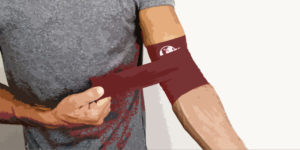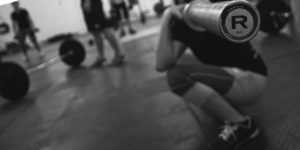While all rugby players need to be strong, it could be argued that Props need raw strength the most. Scrummaging, supporting line-outs, tackling, and hitting rucks and mauls means that most of a prop’s playing time is spent in direct contact with the opposition.
In fact, props are some of the only players who face off one-on-one with their opposite number, and strength can mean the difference between winning and losing the battle of the front rows.
Modern props are also more than just pushing machines – they need to be able to pass, run with the ball and, on occasion, you might even see one perform a nifty sidestep instead of just barreling into the opposition at top speed!
However, the reality is that props need plenty of strength and, if you want to be successful in your role as a prop, your training should reflect the demands of this rugby position.
See some Props in action in the 2015 Rugby World Cup:
Like all rugby players, props need to pay their dues in the gym and develop their strength using a variety of weight lifting exercises. However, this does not mean they should follow a muscle group-specific approach to strength training and follow a bodybuilding-style workout routine. Rather, they should seek out strength exercises that work multiple muscle groups at the same time and, in some way, replicate the demands of rugby . The following is a strength training program for props, designed to give front rowers the functional strength required for the rugby field.
Physical demands of Propping
Props need to be more than just strong, they also need to be powerful, and that means they should also perform some of their exercises explosively. While most props will never be as fast or be able to jump as high as a flanker, that doesn’t mean they shouldn’t shouldn’t be equally powerful!
1. High-Pulls
Owen Franks is a great example of a Prop who can really move some massive weight. check out his high pull below. If you want to train like a rugby prop, you could do worse than just copying Owen’s prop workout programs.
2. Good mornings
If any exercise was prop-specific, the good morning is it. This classic hamstring, glute, and back exercise is tailor-made for props and simulates the demands of scrummaging perfectly. It’s one of those exercises that many gym-goers avoid because it’s tough to master but, for props, this exercise is worth the effort. If you’re struggling with adding weight, try doing some J-Curls to loosen up your lower back and hamstrings.
With a barbell racked on your upper back, stand with your feet shoulder-width apart, knees slightly bent. Push your hips back, hinge forward, and lean over until your upper body is roughly parallel to the floor. Do not round your lower back – unless you want to injure it of course! Stand back up and repeat. While this exercise can be performed using a regular barbell, it’s much more comfortable with a padded safety squat bar or a heavy sandbag.
See this exercise in action here:
3. Landmine push press
This exercise develops full body pushing power – something all props need. If you don’t have a landmine at your gym, just wedge one end of an Olympic bar into a corner and use that instead. Unlike the barbell push press which involves pressing the bar vertically, this exercise involves a more angled approach and is more prop-specific. This exercise can be performed one arm at a time or, if you have a double landmine or two Olympic bars, with both arms simultaneously.
Hold the free end of the barbell at shoulder-height, thumb toward your shoulder. Stand with your feet shoulder-width apart or in a slightly staggered stance as preferred. Keeping your core tight, bend your knees and descend into a quarter-depth squat. Explosively extend your legs and use this momentum to help you drive the weight forward and up to arms’ length. Lower the weight under control back to your shoulder and repeat.
See this exercise in action here:
4. Barbell rollouts
While you might not be able to see them, a prop’s abs are crucial for effective and safe scrummaging. The core is the bridge that connects your upper body to your lower body and a weak core could mean that the forces generated by your arms and legs are “lost” – like trying to shoot a cannon out of a canoe. Crunches and other abs isolation exercises are useful, but the barbell rollout is a much more rugby-specific core exercise because it also involves the arms and legs.
Load a barbell with two 10-kg plates – one at each end. Place the bar on the floor and kneel behind it. Grab the bar with an overhand, shoulder-width grip. Inhale, brace your abs, and then, with straight arms, roll the bar away from you as can. Do not let your chest touch the floor or allow your lower back to hyperextend. Use your abs to pull the bar back to your knees, exhale, and repeat. Make this exercise more demanding by standing up or putting more weight on the bar.
See this exercise in action here:
5. Zercher farmer’s walk
Lifting and carrying heavy weights is one of the most effective ways to develop strength endurance – something that all props need lots of. The Zercher is a variation on the standard Farmer’s Walk which can be found in our supersets sessions eBook. This exercise is a great full body exercise that is so rugby specific it should be compulsory for all players – especially forwards. Use this exercise as a finisher to your strength training program to develop mental toughness, as well as strength endurance and anaerobic fitness.
Grip and hold a barbell in the crook of your arms. Clasp your hands together and held them close to your chest. With the bar in this position, walk 20-meters as fast as you can. This exercise may initially be uncomfortable (suck it up!), but you will soon get used to it. If it proves too uncomfortable, use a squat pad on the bar or wrap the middle of the bar with a towel.
See this exercise in action here:
6. Straight arm sled push
Props are often required to push, and so a Prop’s strength training must include pushing exercises. Barbell and dumbbell exercises, including the bench press and push press, are very valuable but they are not especially sports-specific as they involve not just a lifting phase but a lowering phase too. Pushing is all about driving forward which is where this exercise comes in.
Using a sled with long vertical handles, place your hands at around hip-height and adopt a strong, athletic stance with your legs bent and shoulders by your hands. Initiating the push with your legs, drive the sled forwards and extend your arms. Quickly step forward, reset your position, and repeat. There’s a bonus here as well, since sleds are great for lower body conditioning.
Perform this exercise for distance, e.g. 20-meters, or reps, e.g. 8-12, as preferred.
7. Neck work
If props are known for anything, it’s their strong, bull-like necks! You can usually identify a prop just by his neck measurement. Any prop worth his salt must include neck work in his training. There are lots of different neck exercises you can do, but it’s crucial that you include neck flexion, extension and lateral flexion in your workouts to ensure you are strong in all ranges of movement.
A simple neck harness is one of the best ways to build neck strength as not only can you work all ranges of movement, you can gradually increase the intensity of your workout by adding weight plates. In contrast, body weight exercises like bridges, while useful, are hard to progress or regress and therefore aren’t ideal for building prop strength in the neck and shoulders.
CONCLUSION
Building rugby prop strength starts with a pro-focused workout program. But in addition to training like a prop, you also need to eat as well as possible to support muscle growth and recovery. Complement your rugby diet with either a training stack or recovery stack to get the most from all of your workouts.
A prop’s life is not an easy one but, if that’s where you play, you need to train specifically for the demands of your position. What goes on in the front row of the scrum might be hidden from view much of the time, but that doesn’t mean it’s not a crucial part of rugby. Lose head or tight head, be the best prop you can be by training hard and specifically for this demanding position.
PHOTO: AGENCE FRANCE-PRESSE


